I spent six months of this year working on a book of Bloomingdale’s history for their 150th anniversary. It’s now available online and in stores, and is full of archival images and intriguing stories. With Bloomingdale’s such an integral institution in New York for so long, it is very much also the history of NYC since 1872 and interweaves every possible subject—politics, urban planning, business, fashion, interiors, food, labor rights, etc.
When Bloomingdale’s decided to slowly elevate their goods and clientele in the late 1940s—responding to changes in the neighborhood surrounding the store—they chose to do so first through home furnishings. Until then Bloomingdale’s was known for selling mass-produced, generally inexpensive merchandise and for attention-grabbing sales and promotions; the place where the maids for the Park Avenue elite shopped, not their bosses. Already an incredibly successful store, the decision to shift focus was taken with great trepidation and planning—potentially ruining customer relationships before gaining new ones was an enormous risk but one that President James S. Schoff and chairman J. Edward Davidson (both recent hires) felt was necessary. In an effort to recast the store in the public eye, a series of grand parties and events were put on to mark the seventy-fifth anniversary in 1947; among them was an “architectural competition” for the design of private homes in the now-booming New York suburban area, which took over the newly renovated sixth-floor with the winning models and life-size model rooms designed by top furniture designers including George Nelson and Edward Wormley. Even with these efforts, Bloomingdale’s couldn’t just approach the top American furniture makers (and fashion designers) and ask them to supply their products—“The manufacturers would have… strenuously objected to the damage their own reputations might have suffered if their merchandise were sold in the same establishment as inexpensive, low-quality goods.”
Attempting a different path, antiques connoisseur Davidson sent his home furnishings staff to a still chaotic post-war Europe to look for unexpected antiques in private homes and museums that could be easily reproduced for export to the US. They also sought out unknown artisans and makers. Filling the store with pieces that weren’t available anywhere else, through the 1950s Bloomingdale’s furniture department started to become known as a place of elevated taste under the elegant eye of the fashion coordinator for home furnishings Henriette Granville. When she resigned in 1957, her assistant Barbara D’Arcy took over and brought with her a younger, more innovative perspective that led her to become known as one of the major trendsetters in American interior design over the next sixteen years. D’Arcy continued to travel to Europe to find hip young designers and antiques to reproduce—she was known to sometimes bribe museum guards “to let them carry historic pieces of furniture into a courtyard for better light in sketching, photographing and measuring them”—which she made sure the Italian artisans aged to look old, a novel idea at the time.
The model rooms—life-size, fully decorated rooms—were the site of trend creation and influence-making. D’Arcy designed these spaces so that as the customer walked through them, they could imagine and play-act as if they were in their own home—sit down on a bed in a traditional, heavy wood bedroom and then wander next door to a sleekly modern, glass-and-chrome living room. Interior designers visited to get ideas for clients, locals came to pick up something to refresh their homes, and occasionally customers purchased the whole rooms down to carpet, glasses and window shades. Twice a year, mid-spring and early fall, the seven or eight rooms would completely change into new vignettes that often required full structural changes. In the words of the NY Times, they became “a mecca in the 1950s for those who aspired to learn what was stylish, sophisticated, well-made but not too expensive in a living room set or a window treatment.”
As D’Arcy’s ideas began to permeate the homes of New Yorkers, Bloomingdale’s was still working to shift their reputation to one of high-end spectacle. In 1960 they held their first import fair, “Casa Bella,” an ode to Italy centered on its furniture and home goods. D’Arcy designed the first of many themed model rooms for this fair—a tradition she would continue through the subsequent nine annual events, ones that ranged from “L’Esprit de France” to the show business-themed “All the World’s a Stage.” Even as the promotions expanded to include every department, the model rooms were always the centerpiece.
The final annual fair of this first era (Bloomingdale’s took a break from hosting such promotions from 1971-1977, and then continued with them from 1978-1992) was “The Creators”: “The homes we live in, the way we dress, even the food we eat, in short, our life style has always been influenced by a gifted few whose vision has given joy and meaning to the many.” It included, across the store, an edition of signed prints from the Pace Gallery from such artists as Louise Nevelson and Max Ernst; a Vasarely rug gallery; the first US showing of the Swedish crystal company Orrefors; an outpost of the Denise Rene Gallery; a shop of objects by Danish artist Bjørn Wiinblad; Pierre Cardin’s first full environment (the furniture, bedding, etc. that would become such a big part of his brand in the seventies); and needlework kits designed by celebrities like Dina Merrill and Muriel Humphrey (wife of former VP Hubert).
Fourteen model rooms took over the sixth floor, each inspired by “the taste, personalities and whims of such culture-creators as Françoise Sagan, Anne Klein and Peter Max.” Designed by D’arcy, Bloomingdale’s head decorator David Eugene Bell (who each had a room devoted to them too), and other invited interior designers, the spaces were often more like immersive environments than simply rooms.
On hand at the opening on September 22, 1970, were a few of the selected “Creators”: Neil Simon, Burt Bacharach, Bill Blass, and Peter May. No expense had been spared, no fantasy untested—the rooms were a masterpiece of creativity and experimentation. While many of them looked wild to most customers, they were strictly commercial—designed “to present things so that people see something and feel that they can’t live without it.” Maybe you wouldn’t want a steel fireplace, but the steel plant pot next to it? D’Arcy and her team were always making sure that there was something to inspire everyone, no matter their home aesthetic. She continued to design the model rooms until September 1973, when she was promoted to director of merchandise presentation—putting her in charge of the interior design of the whole flagship store as well as the branches. Thirty-five-year-old Richard Knapple took over model room duty for almost twenty years. Barbara D’Arcy retired from Bloomingdale’s in 1995; she passed away in 2012.
D'Arcy designed a room inspired by Pierre Cardin (this was in addition to his furnishings shop). According to D’Arcy, “I met Cardin in Paris. He told me he doesn’t like sharp edges. He thinks the world is tough enough without having sharp corners to bump into at home”—hence the cave-like setting she designed complete with undulating wavy panels protruding from the ceiling and free-form mirrors inlaid into gray felt-covered walls. D’Arcy later said of the gray, steel and purple space: "Certainly this is not a room for everyone, but if you want to indulge your fantasies and can live in this sort of environment, this is one way to do it."
For her own room, she created a “multileveled environment with beamed ceilings; strong bright colors, including her favorites, orange and purple; and her signature eclectic mix of furniture: French antiques, a modern Plexiglas table, African sculptures, baskets galore. The white plaster walls, painted beamed ceiling, and fireplace presaged the Sante Fe [sic] look.” It was featured on the front cover of Bloomingdale's Book of Home Decorating, written by D’Arcy in 1973.
Neil Simon inspired a living room with a bronze acrylic plastic floor and clear plastic furniture with working kinetic and light effects—rotating lit-up shelving columns and a “walking” table that was programmed to periodically move around the room serving drinks.
For Blass, designer John Harris created a lighted Plexiglas bed. The terracotta mantle was found in Florence and shipped to the US.
D’Arcy: “This is a collection of very provincial French furniture. It’s heavy and rustic and comes ready to be painted in any color you want and can think of. It can fit into a contemporary or a severe setting.”
“Here the highly lacquered walls, the dull-satin upholstery, marble—both real and painted—and the furniture are all the same tone of color. Variety in texture gives the color strong impact and yet the room is ultra-feminine.”







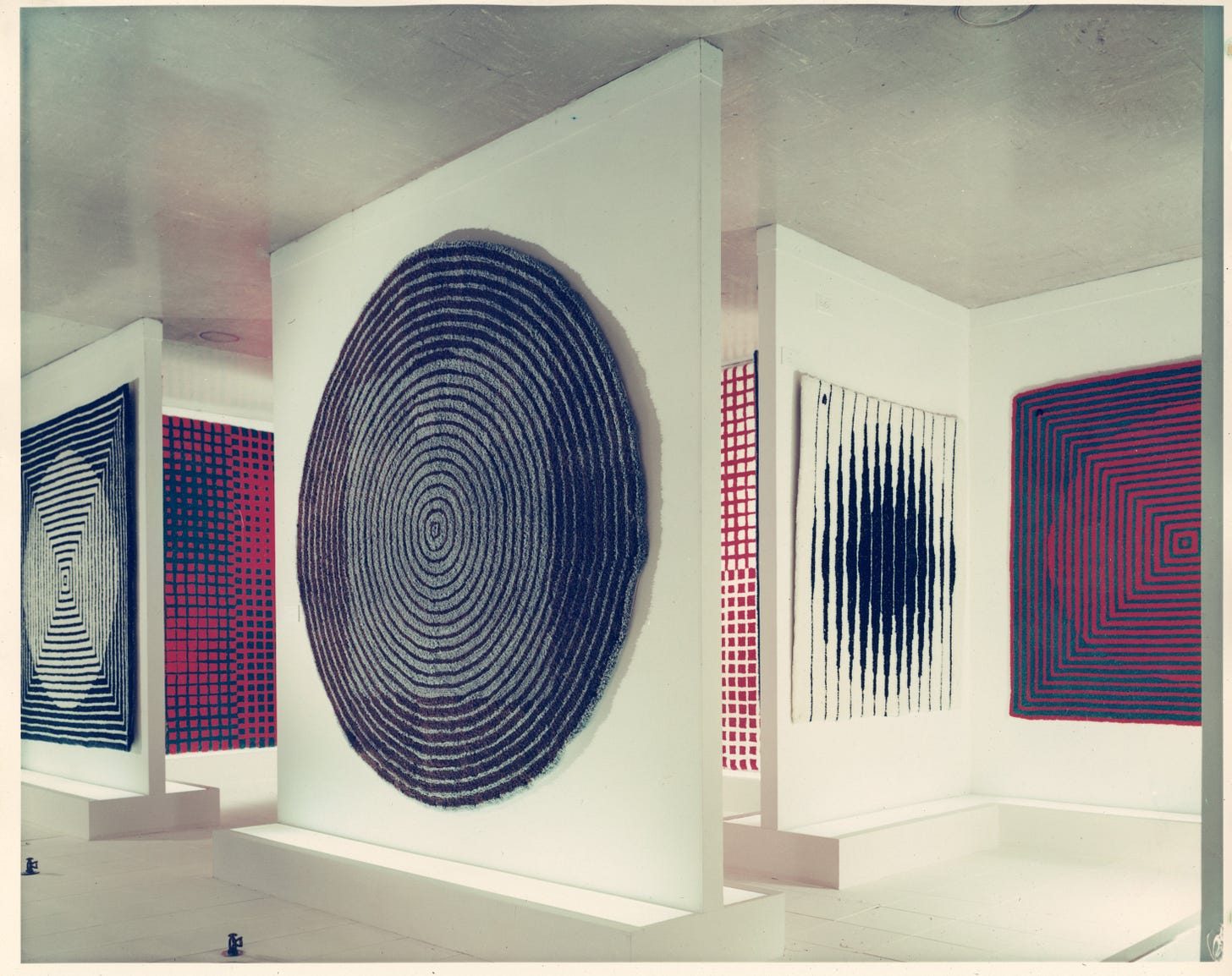
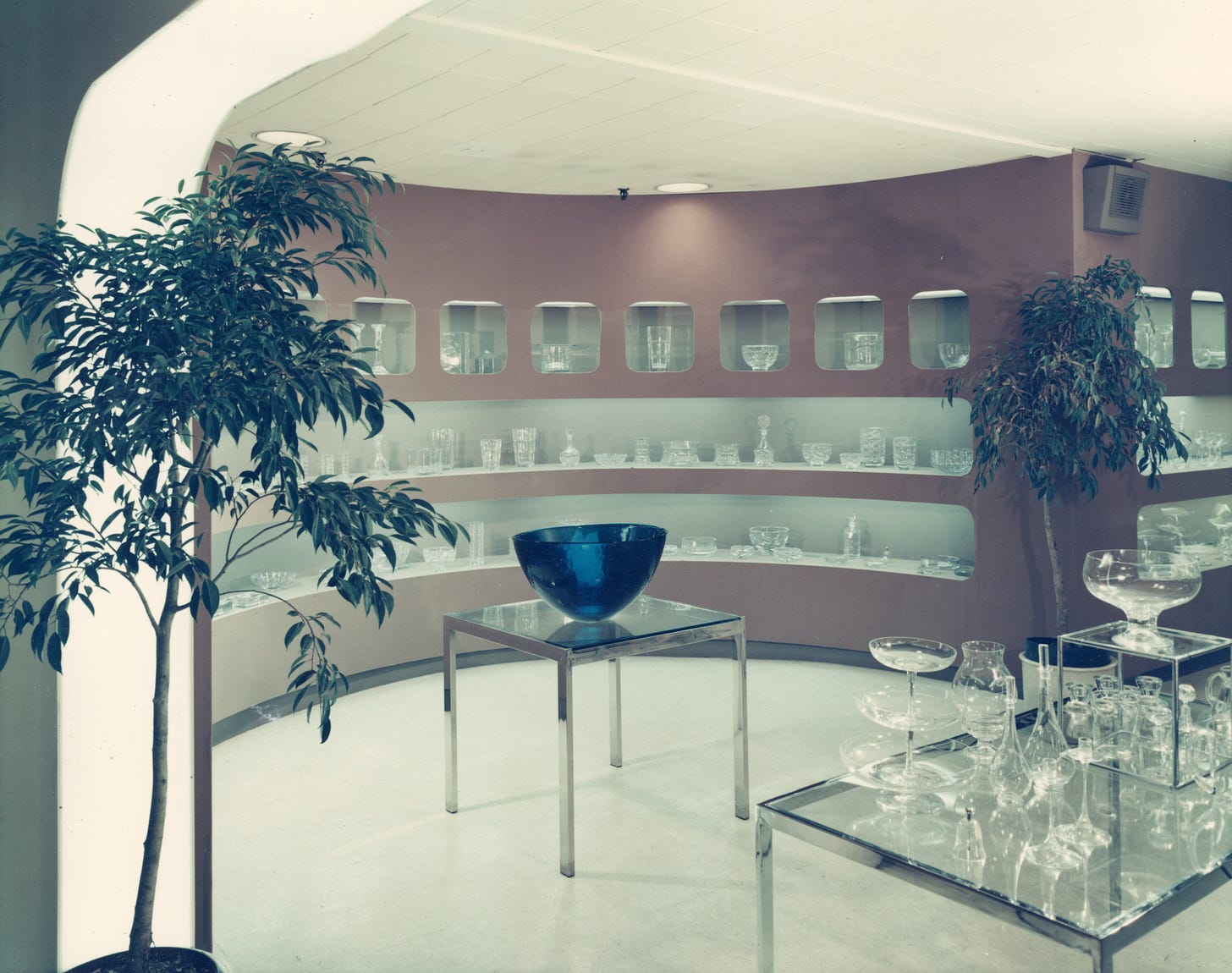
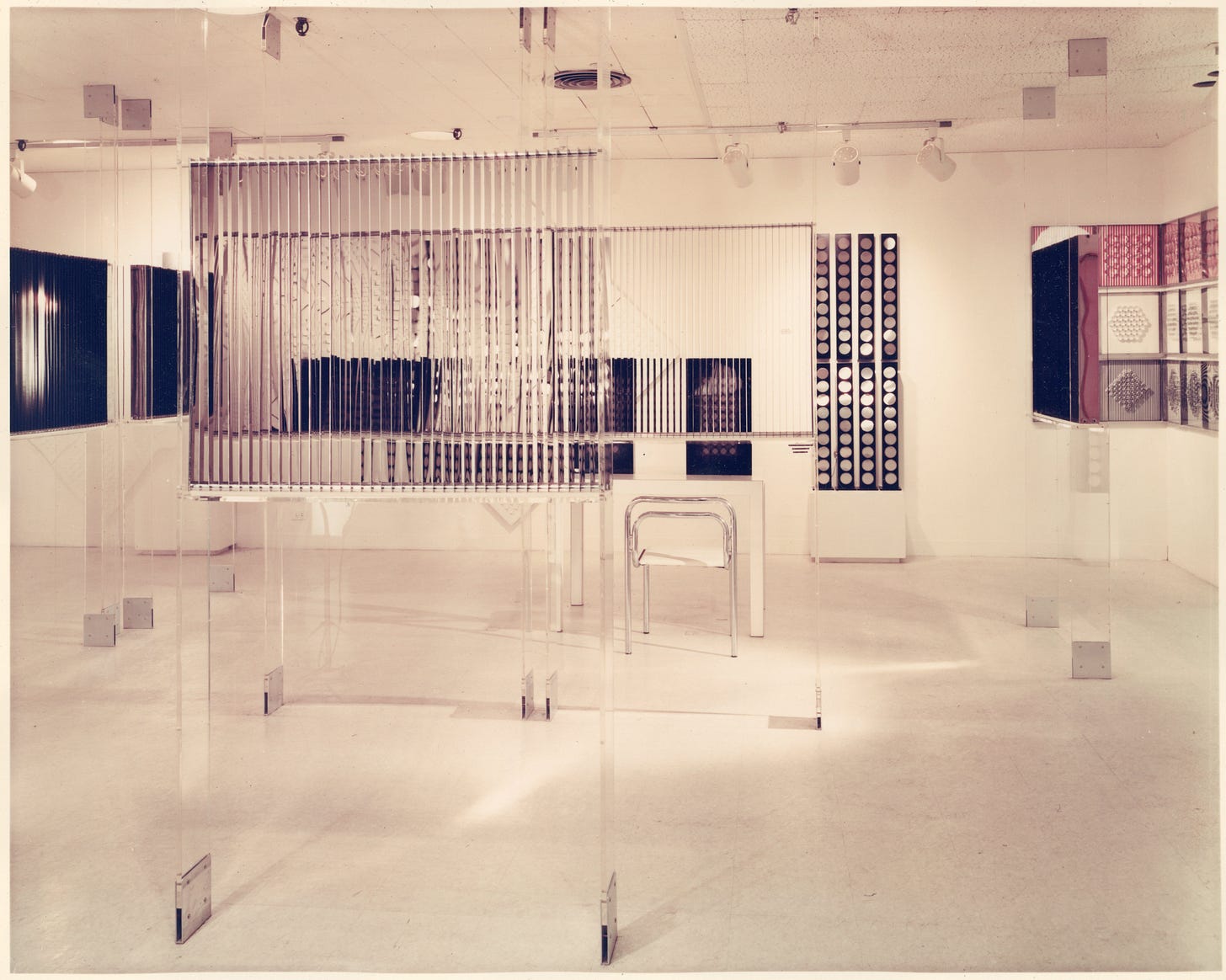


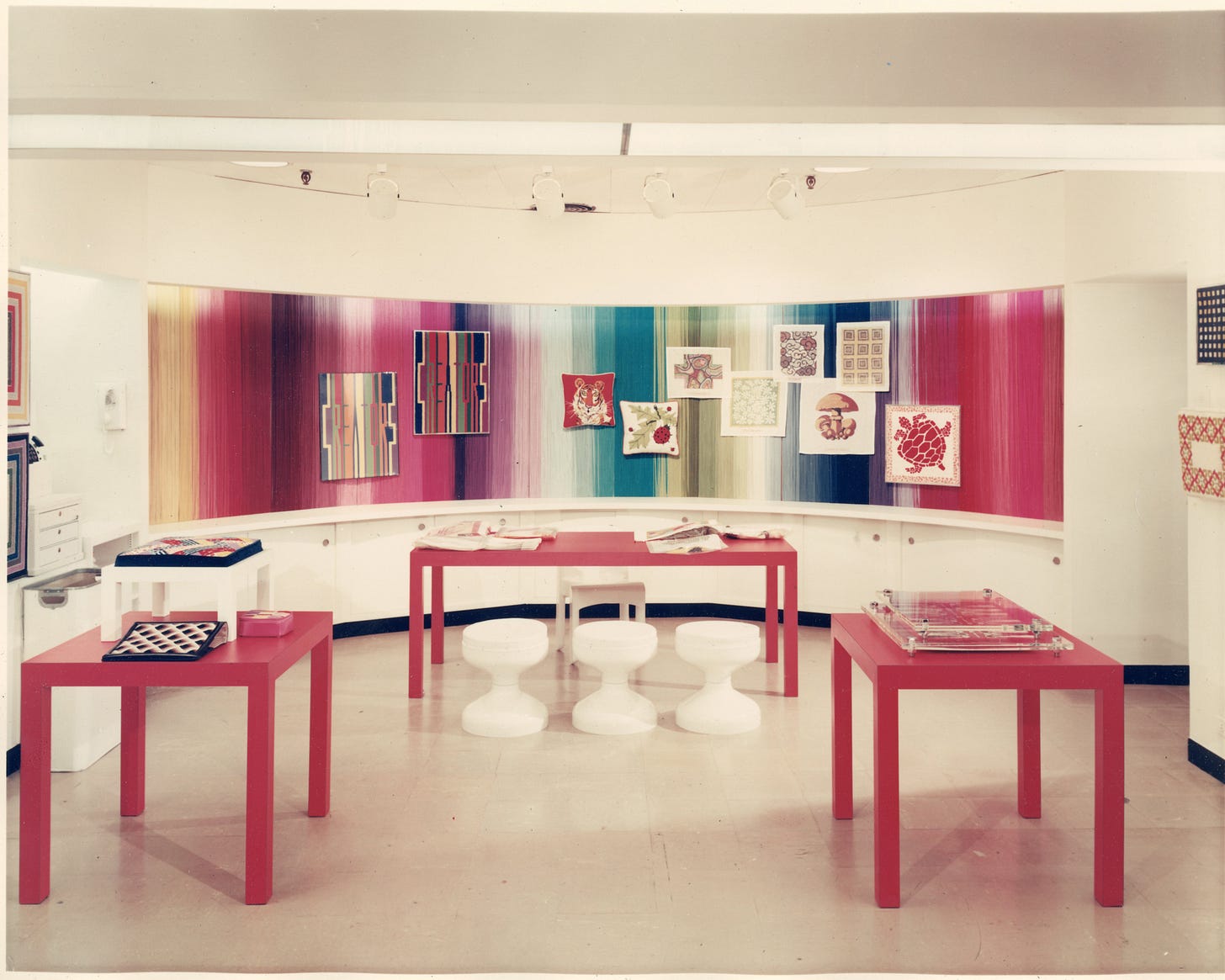

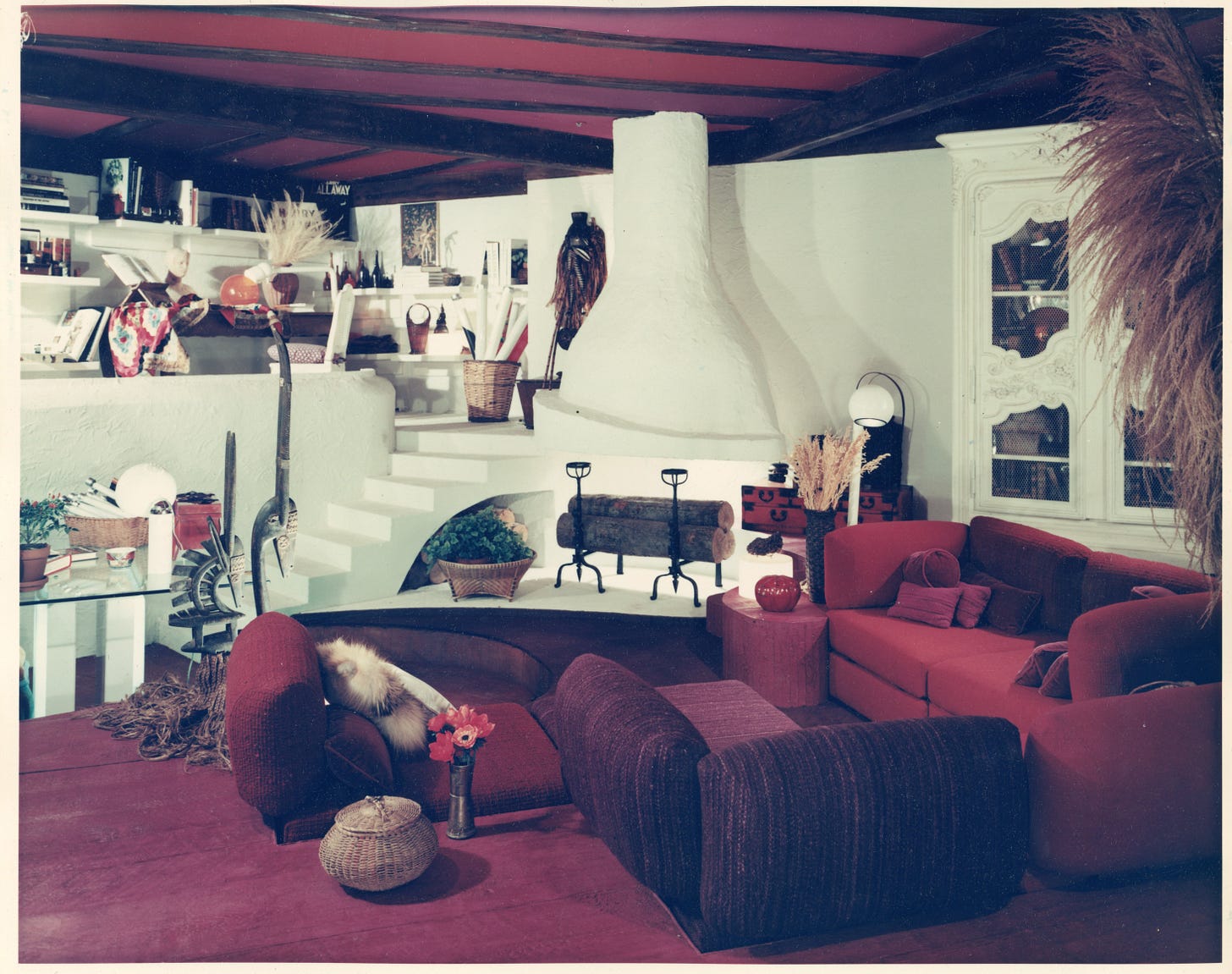




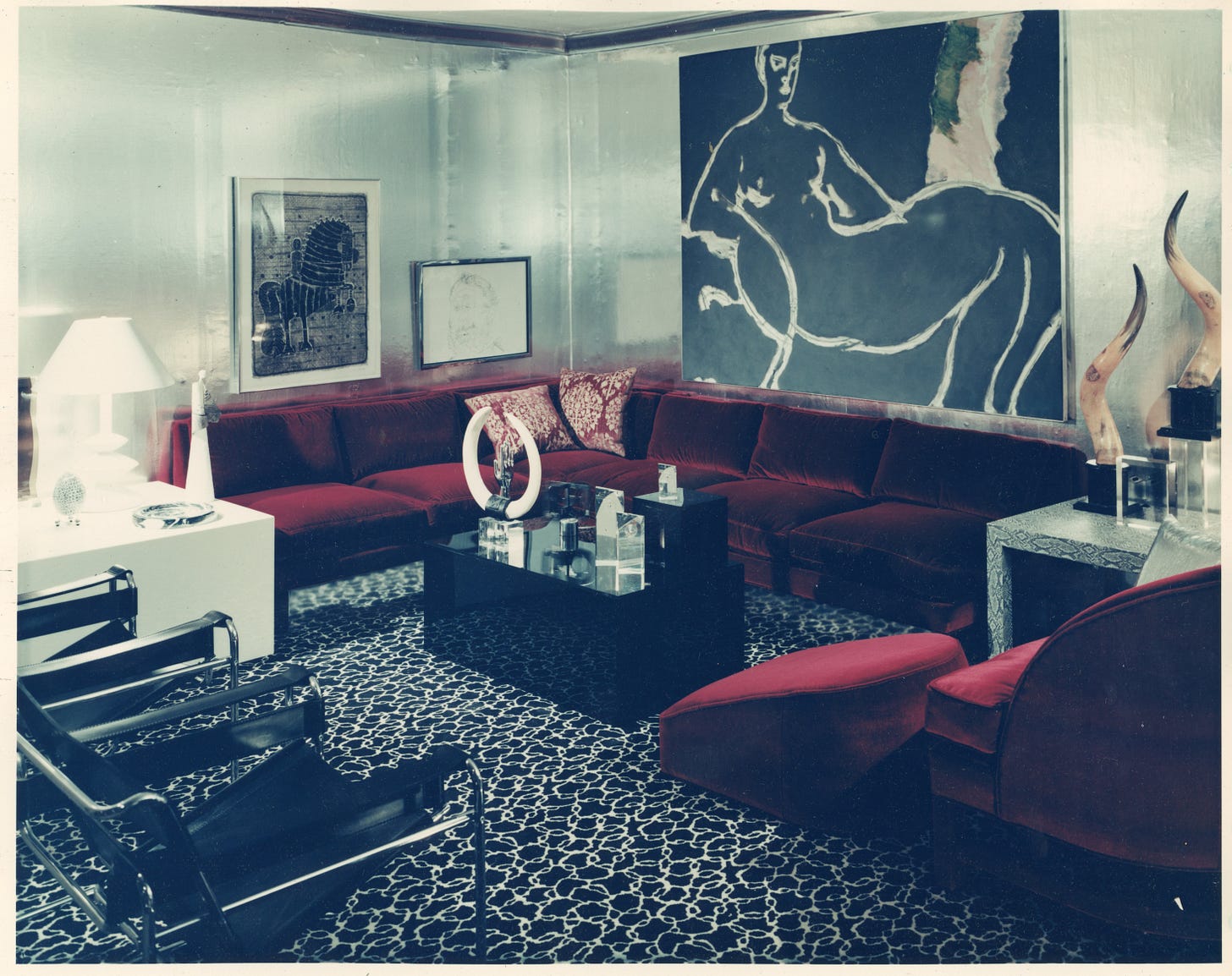


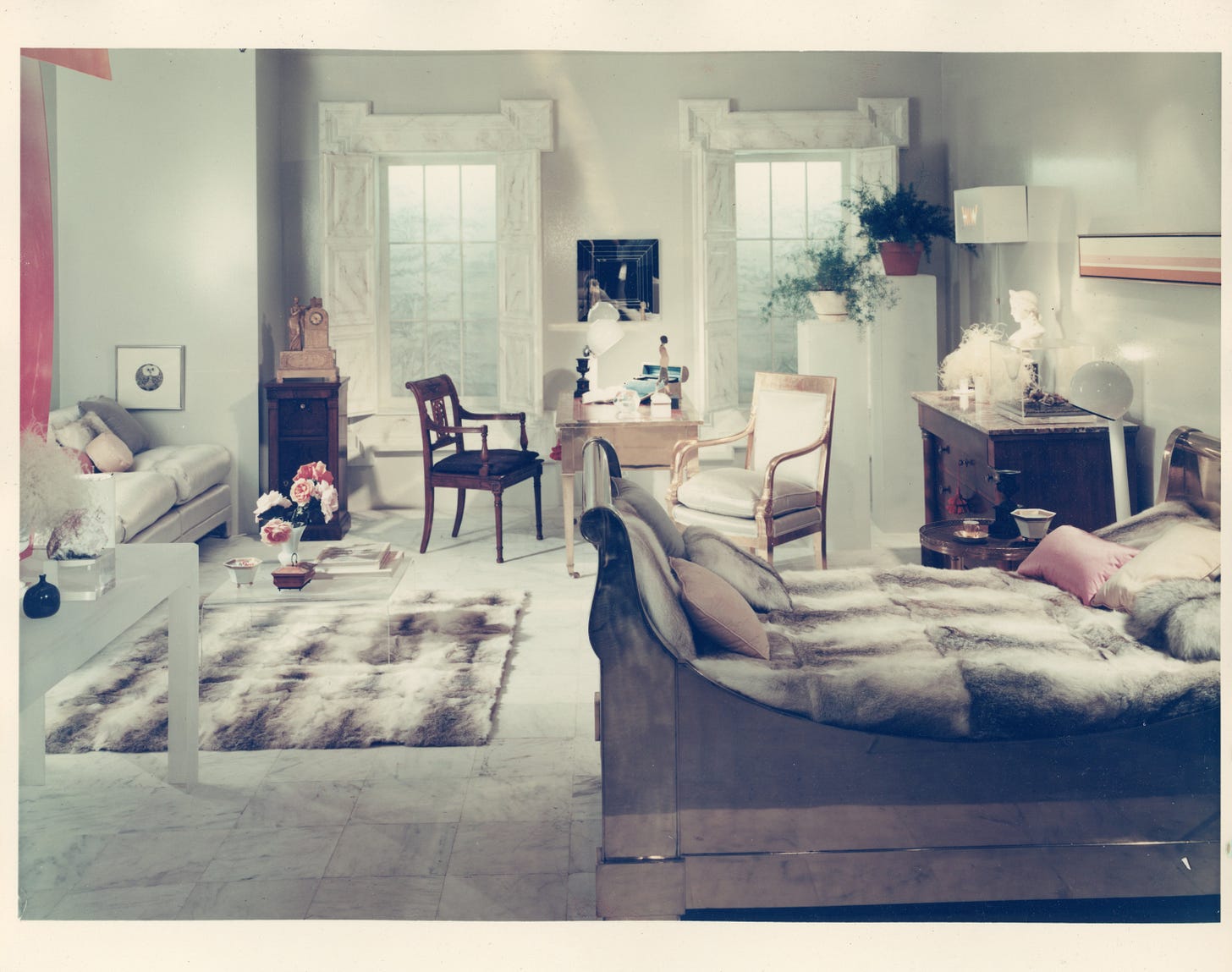
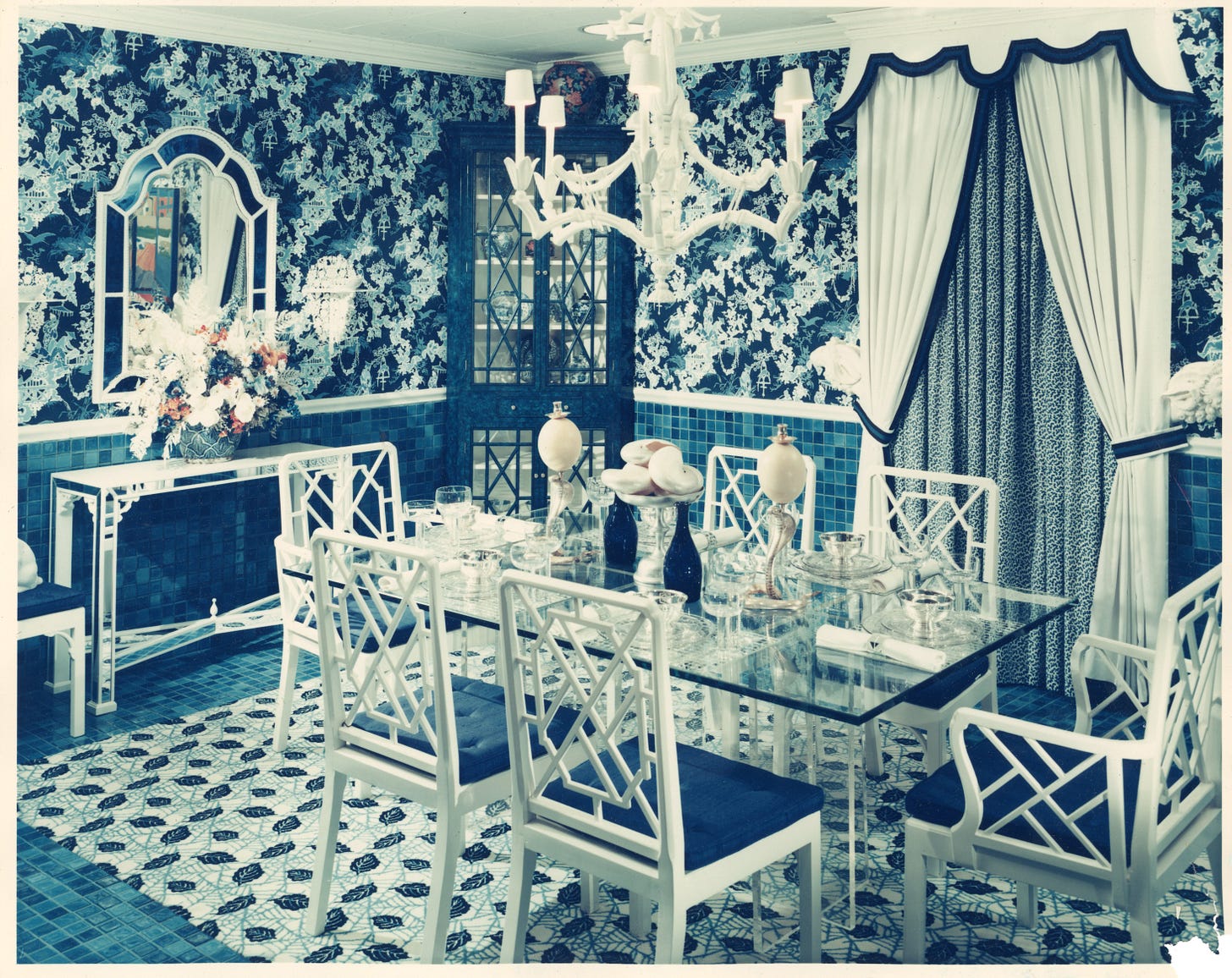


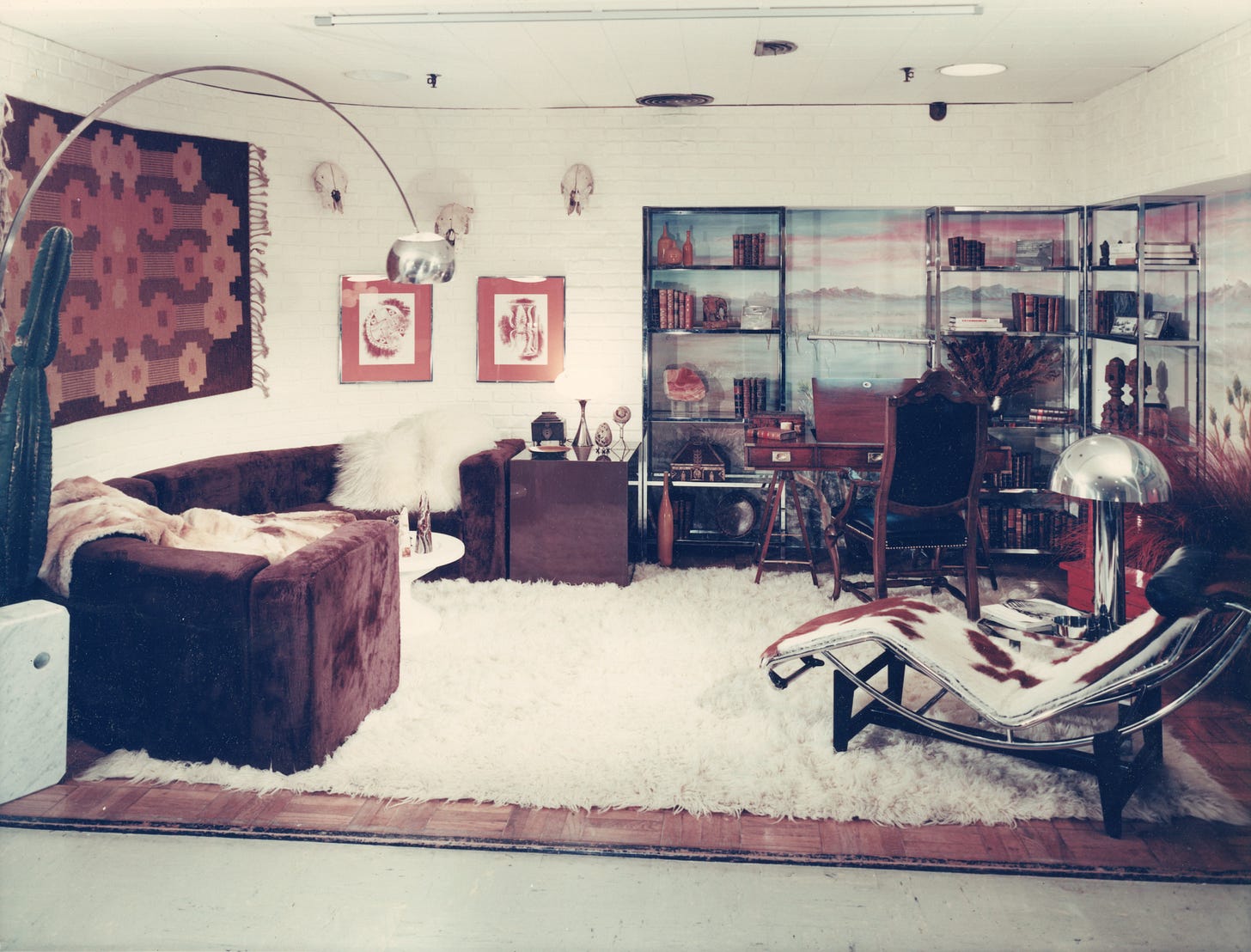


Oooooh! I can’t wait to see this!
Beautiful Laura! You just hurled me back into being with my mom pursuing those rooms.❤️